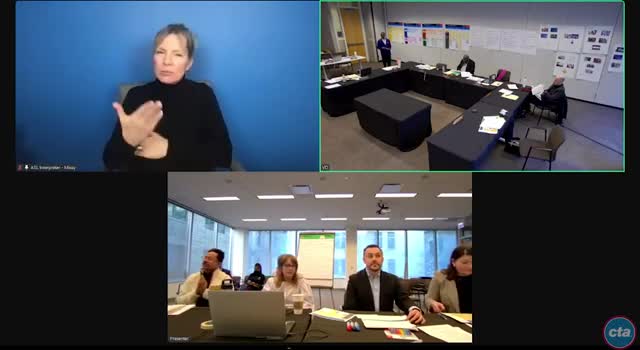CTA staff previews customer journey mapping, four rider personas and 2025 actions
January 25, 2025 | Chicago Transit Authority Board, C, Boards and Commissions, Executive, Illinois
This article was created by AI summarizing key points discussed. AI makes mistakes, so for full details and context, please refer to the video of the full meeting. Please report any errors so we can fix them. Report an error »

CTA customer experience staff used the retreat to present a structured customer‑journey framework and four persona profiles the agency plans to use when prioritizing 2025 work. Nicholas Krone, vice president (Fair Systems, Office of Planning and Innovation), told the board the project consolidates quantitative and qualitative sources — Ventra trip data, surveys and focus groups — into a single journey map and prioritized actions.
Staff described four illustrative personas — an “excited visitor,” an “independent commuter,” a “dedicated mom” and a “senior commuter” — and asked the board to help map which of CTA’s planned 2025 activities best address each persona’s chief frustrations. “Benefits of customer personas is that they really help identify the general truths about our customers,” Krone told directors.
Directors and staff used the exercise to surface immediate priorities: perceptions of personal safety and security, station and vehicle cleanliness, reliable on‑time performance, and clearer real‑time information. Staff also described a technical outreach gap: only about half of Ventra accounts are fully registered with an email address, limiting direct reengagement opportunities for riders who have stopped riding.
On tactics, presenters proposed targeted messages to “dormant” riders, more frequent and visible cleaning, and strengthened customer reporting and follow‑up. The presentation flagged a tradeoff familiar to the board: whether to measure short‑term financial returns on property and program investments or to prioritize longer‑term community returns that build ridership and equity.
Ending: Staff asked for board input on which planned 2025 activities to prioritize and for help in setting measurable targets (for example: specific on‑time targets, cleanliness metrics and an outreach cadence to reengage dormant riders). Board members suggested the agency should test outreach incentives for low‑frequency riders and improve frontline‑staff training so customer interactions reflect the organization’s stated values.
Staff described four illustrative personas — an “excited visitor,” an “independent commuter,” a “dedicated mom” and a “senior commuter” — and asked the board to help map which of CTA’s planned 2025 activities best address each persona’s chief frustrations. “Benefits of customer personas is that they really help identify the general truths about our customers,” Krone told directors.
Directors and staff used the exercise to surface immediate priorities: perceptions of personal safety and security, station and vehicle cleanliness, reliable on‑time performance, and clearer real‑time information. Staff also described a technical outreach gap: only about half of Ventra accounts are fully registered with an email address, limiting direct reengagement opportunities for riders who have stopped riding.
On tactics, presenters proposed targeted messages to “dormant” riders, more frequent and visible cleaning, and strengthened customer reporting and follow‑up. The presentation flagged a tradeoff familiar to the board: whether to measure short‑term financial returns on property and program investments or to prioritize longer‑term community returns that build ridership and equity.
Ending: Staff asked for board input on which planned 2025 activities to prioritize and for help in setting measurable targets (for example: specific on‑time targets, cleanliness metrics and an outreach cadence to reengage dormant riders). Board members suggested the agency should test outreach incentives for low‑frequency riders and improve frontline‑staff training so customer interactions reflect the organization’s stated values.
View the Full Meeting & All Its Details
This article offers just a summary. Unlock complete video, transcripts, and insights as a Founder Member.
✓
Watch full, unedited meeting videos
✓
Search every word spoken in unlimited transcripts
✓
AI summaries & real-time alerts (all government levels)
✓
Permanent access to expanding government content
30-day money-back guarantee

